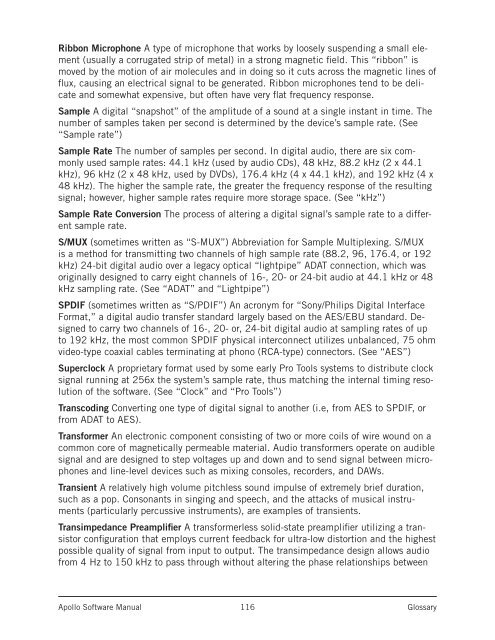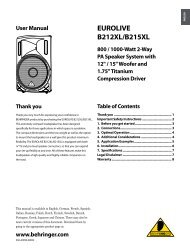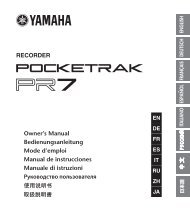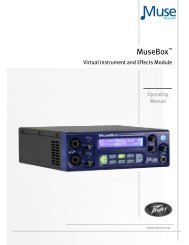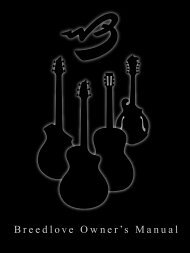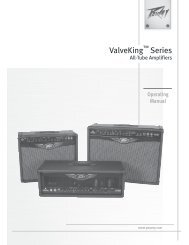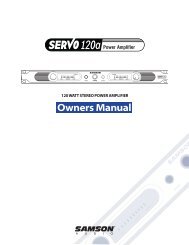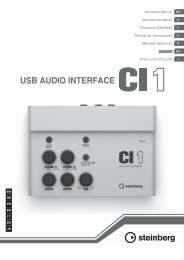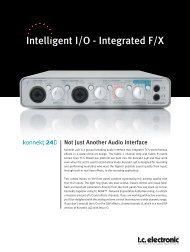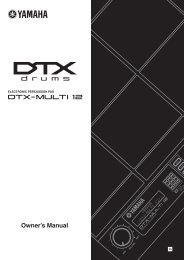You also want an ePaper? Increase the reach of your titles
YUMPU automatically turns print PDFs into web optimized ePapers that Google loves.
Ribbon Microphone A type of microphone that works by loosely suspending a small element(usually a corrugated strip of metal) in a strong magnetic field. This “ribbon” ismoved by the motion of air molecules and in doing so it cuts across the magnetic lines offlux, causing an electrical signal to be generated. Ribbon microphones tend to be delicateand somewhat expensive, but often have very flat frequency response.Sample A digital “snapshot” of the amplitude of a sound at a single instant in time. Thenumber of samples taken per second is determined by the device’s sample rate. (See“Sample rate”)Sample Rate The number of samples per second. In digital audio, there are six <strong>com</strong>monlyused sample rates: 44.1 kHz (used by audio CDs), 48 kHz, 88.2 kHz (2 x 44.1kHz), 96 kHz (2 x 48 kHz, used by DVDs), 176.4 kHz (4 x 44.1 kHz), and 192 kHz (4 x48 kHz). The higher the sample rate, the greater the frequency response of the resultingsignal; however, higher sample rates require more storage space. (See “kHz”)Sample Rate Conversion The process of altering a digital signal’s sample rate to a differentsample rate.S/MUX (sometimes written as “S-MUX”) Abbreviation for Sample Multiplexing. S/MUXis a method for transmitting two channels of high sample rate (88.2, 96, 176.4, or 192kHz) 24-bit digital audio over a legacy optical “lightpipe” ADAT connection, which wasoriginally designed to carry eight channels of 16-, 20- or 24-bit audio at 44.1 kHz or 48kHz sampling rate. (See “ADAT” and “Lightpipe”)SPDIF (sometimes written as “S/PDIF”) An acronym for “Sony/Philips Digital InterfaceFormat,” a digital audio transfer standard largely based on the AES/EBU standard. Designedto carry two channels of 16-, 20- or, 24-bit digital audio at sampling rates of upto 192 kHz, the most <strong>com</strong>mon SPDIF physical interconnect utilizes unbalanced, 75 ohmvideo-type coaxial cables terminating at phono (RCA-type) connectors. (See “AES”)Superclock A proprietary format used by some early Pro Tools systems to distribute clocksignal running at 256x the system’s sample rate, thus matching the internal timing resolutionof the software. (See “Clock” and “Pro Tools”)Transcoding Converting one type of digital signal to another (i.e, from AES to SPDIF, orfrom ADAT to AES).Transformer An electronic <strong>com</strong>ponent consisting of two or more coils of wire wound on a<strong>com</strong>mon core of magnetically permeable material. Audio transformers operate on audiblesignal and are designed to step voltages up and down and to send signal between microphonesand line-level devices such as mixing consoles, recorders, and DAWs.Transient A relatively high volume pitchless sound impulse of extremely brief duration,such as a pop. Consonants in singing and speech, and the attacks of musical instruments(particularly percussive instruments), are examples of transients.Transimpedance Preamplifier A transformerless solid-state preamplifier utilizing a transistorconfiguration that employs current feedback for ultra-low distortion and the highestpossible quality of signal from input to output. The transimpedance design allows audiofrom 4 Hz to 150 kHz to pass through without altering the phase relationships between<strong>Apollo</strong> <strong>Software</strong> <strong>Manual</strong>116Glossary


